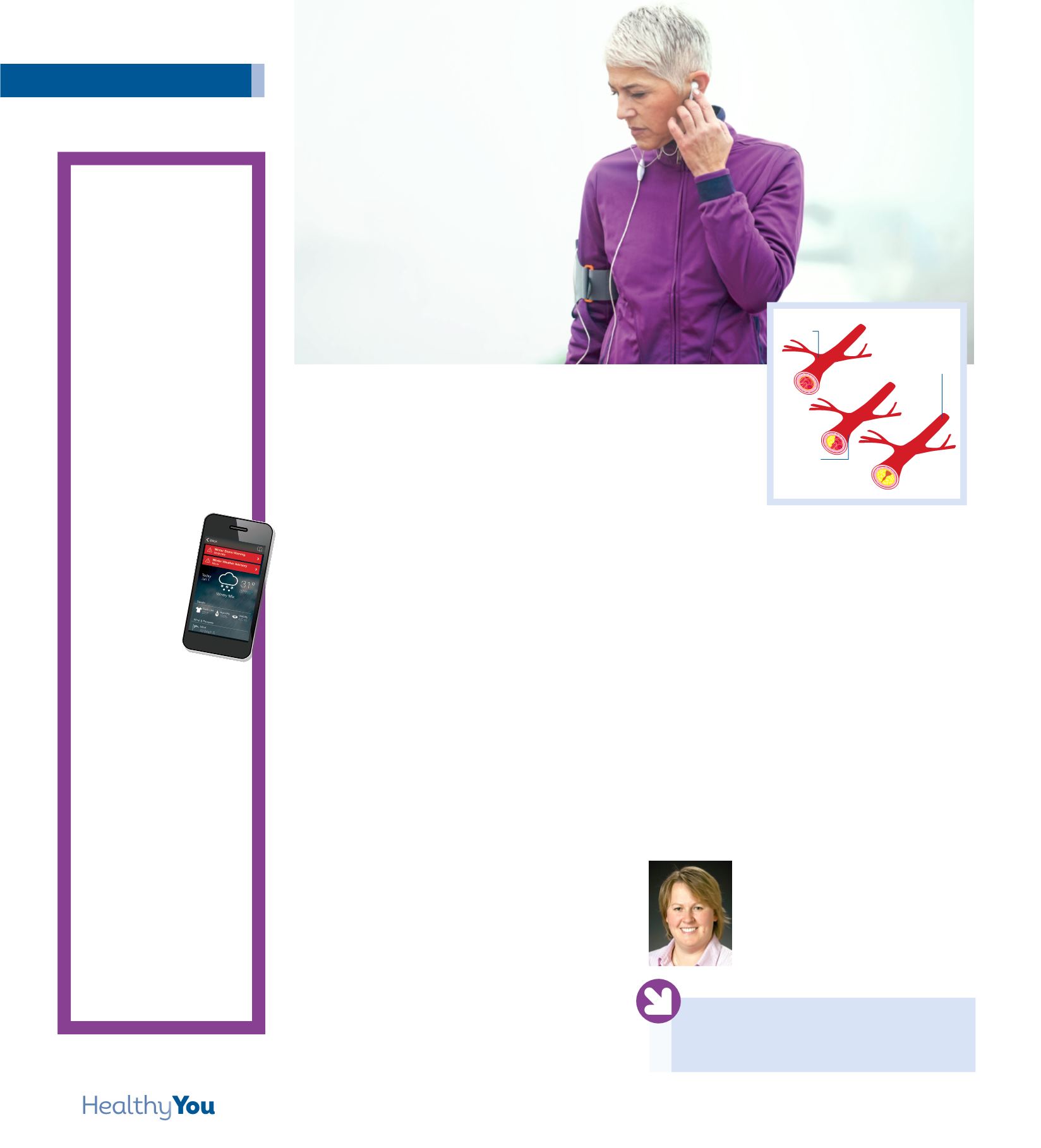

HEART AT TACKS HAPPEN
to both women and
men—but they don’t always look the same. They’re not as
obvious as you’d see on TV, and that’s true for more women
than men.
Here’s a look at what makes recognizing a heart attack so
important—and why noticing more subtle signs is especially
important for women.
What to look for
What does a heart attack feel like? Chest pain or discomfort
is the most common symptom for both women and men.
The pain may last a few minutes or come and go. Some
people say it feels like pressure, squeezing, or fullness. Or it
may feel like an upset stomach or heartburn.
“But women are more likely than men to have other heart
attack signs,” says Margo Kozinski, MD, a cardiologist with
the Heart & Vascular Cardiology Clinic. Those can include:
■ ■
Shortness of breath with or without chest pain
■ ■
Nausea, lightheadedness, or vomiting
■ ■
Unexplained fatigue that may last for days
■ ■
Back, shoulder, arm, or jaw pain
Women are also at higher risk for silent heart attacks,
according to some studies. This is when symptoms of a heart
attack are so mild that they go unnoticed—or are dismissed
as anxiety.
“Silent heart attacks are just as dangerous as more obvious
heart attacks, though,” Dr. Kozinski says. “Left untreated,
they can cause scarring and permanent damage, raising the
risk of other heart problems.”
So don’t be too quick to dismiss shortness of breath or
lightheadedness as just anxiety. And make sure you tell
medical professionals that you think you’re having a heart
attack, not an anxiety attack.
A supply problem at the pump
Despite women’s more subtle symptoms, the mechanics of
a heart attack are fundamentally the same for both sexes.
It happens when
the heart’s blood
supply is reduced
or cut off, most
often when an
artery becomes
blocked.
What usually sets the stage? Doctors call it
atherosclerosis. It happens when arteries that bring
blood to the heart slowly become clogged with plaque.
A piece of plaque can form a clot that keeps oxygen-rich
blood from reaching the heart.
Without prompt treatment, areas of heart muscle may die
and eventually be replaced by scars. This damage could leave
a heart attack survivor with a weakened heart.
“And a weak heart may not be able to pump blood to the
body’s organs like it should, which could result in other
quality-of-life issues,” Dr. Kozinski says.
Quick treatment can restore blood flow to the heart and
help prevent damage. So be aware of these warning signs for
both yourself and others. If there’s even a slight chance you
could be having a heart attack, don’t wait. Call 911 and get to
a hospital to give your heart the best chance.
Anatomy
of a heart
attack
It’s different for women
Put your
heart into
cold-weather
exercise
Regular exercise is
good for the heart. But
exercising outdoors in
cold weather can lead
to chest pain for people
with heart disease and
can be challenging in
other ways.
That doesn’t mean you
need to take the winter
off, however. To keep
moving all year:
■
■
Check the
forecast.
If
dangerous cold
or windchills
are predicted,
take your
workouts
indoors. Jog
in place. Do some
pushups. Use a workout
DVD or online video.
■
■
Dress in insulating
layers
that you can
remove if needed. Don’t
forget a hat or headband
and gloves. And if you
start to shiver, head
indoors.
■
■
Watch your step.
Icy sidewalks and
other surfaces may be
treacherous.
If you have a heart
problem, seek a doctor’s
advice about cold-
weather exercise.
Margo Kozinski, MD
Cardiology
Heart & Vascular Cardiology Clinic
200 NE Mother Joseph Place
Vancouver, WA
360-514-4444
I
♥
checkups! HeartCheck 360° Screening
Clinic $189. No physician referral required.
Call
360-514-7755
or
877-501-5055
.
Normal
artery
Artery
narrowed by
atherosclerotic
plaque
Partially
blocked
artery
4
Heart health
















